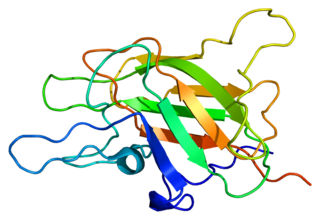Related Research Articles

Anticoagulants,commonly known as blood thinners,are chemical substances that prevent or reduce coagulation of blood,prolonging the clotting time. Some of them occur naturally in blood-eating animals such as leeches and mosquitoes,where they help keep the bite area unclotted long enough for the animal to obtain some blood. As a class of medications,anticoagulants are used in therapy for thrombotic disorders. Oral anticoagulants (OACs) are taken by many people in pill or tablet form,and various intravenous anticoagulant dosage forms are used in hospitals. Some anticoagulants are used in medical equipment,such as sample tubes,blood transfusion bags,heart–lung machines,and dialysis equipment. One of the first anticoagulants,warfarin,was initially approved as a rodenticide.

Coagulation,also known as clotting,is the process by which blood changes from a liquid to a gel,forming a blood clot. It potentially results in hemostasis,the cessation of blood loss from a damaged vessel,followed by repair. The mechanism of coagulation involves activation,adhesion and aggregation of platelets,as well as deposition and maturation of fibrin.

Thrombin is a serine protease,an enzyme that,in humans,is encoded by the F2 gene. Prothrombin is proteolytically cleaved to form thrombin in the clotting process. Thrombin in turn acts as a serine protease that converts soluble fibrinogen into insoluble strands of fibrin,as well as catalyzing many other coagulation-related reactions.

Ximelagatran is an anticoagulant that has been investigated extensively as a replacement for warfarin that would overcome the problematic dietary,drug interaction,and monitoring issues associated with warfarin therapy. In 2006,its manufacturer AstraZeneca announced that it would withdraw pending applications for marketing approval after reports of hepatotoxicity during trials,and discontinue its distribution in countries where the drug had been approved.

Draculin is a glycoprotein found in the saliva of vampire bats. It is a single-chain polypeptide protein composed of 708 amino acids,weighing about 88.5 kDa when reduced and 83 kDa when non-reduced,and selectively inhibits FIXa and FXa. It functions as an anticoagulant,inhibiting coagulation factors IX (IXa) and X (Xa) by establishing rapid equilibrium with factor Xa,and is the first natural polypeptide which has been described to show immediate anti-IXa and anti-Xa properties. In addition,Draculin inhibits the conversion of prothrombin to thrombin,preventing fibrinogen from converting to fibrin. These two processes inhibit blood coagulation thus keeping the blood of the bitten victim from clotting while the bat is drinking. The activation of factor X is a common point between the intrinsic and extrinsic pathway of blood coagulation. Activated factor X (FXa) is the sole enzyme that catalyzes the conversion of prothrombine into thrombin,which is vital in the coagulation cascade. Draculin is a member of the Lactoferrin family of proteins that functions as an antibacterial protein in other mammals,but has been co-opted in bat evolution to function as an anticoagulant.

Thrombophilia is an abnormality of blood coagulation that increases the risk of thrombosis. Such abnormalities can be identified in 50% of people who have an episode of thrombosis that was not provoked by other causes. A significant proportion of the population has a detectable thrombophilic abnormality,but most of these develop thrombosis only in the presence of an additional risk factor.

Factor X,also known by the eponym Stuart–Prower factor,is an enzyme of the coagulation cascade. It is a serine endopeptidase. Factor X is synthesized in the liver and requires vitamin K for its synthesis.

Factor V is a protein of the coagulation system,rarely referred to as proaccelerin or labile factor. In contrast to most other coagulation factors,it is not enzymatically active but functions as a cofactor. Deficiency leads to predisposition for hemorrhage,while some mutations predispose for thrombosis.

Hirudin is a naturally occurring peptide in the salivary glands of blood-sucking leeches that has a blood anticoagulant property. This is essential for the leeches' habit of feeding on blood,since it keeps a host's blood flowing after the worm's initial puncture of the skin.

Argatroban is an anticoagulant that is a small molecule direct thrombin inhibitor. In 2000,argatroban was licensed by the Food and Drug Administration (FDA) for prophylaxis or treatment of thrombosis in patients with heparin-induced thrombocytopenia (HIT). In 2002,it was approved for use during percutaneous coronary interventions in patients who have HIT or are at risk for developing it. In 2012,it was approved by the MHRA in the UK for anticoagulation in patients with heparin-induced thrombocytopenia Type II (HIT) who require parenteral antithrombotic therapy.
The prothrombinase complex consists of the serine protease,Factor Xa,and the protein cofactor,Factor Va. The complex assembles on negatively charged phospholipid membranes in the presence of calcium ions. The prothrombinase complex catalyzes the conversion of prothrombin (Factor II),an inactive zymogen,to thrombin (Factor IIa),an active serine protease. The activation of thrombin is a critical reaction in the coagulation cascade,which functions to regulate hemostasis in the body. To produce thrombin,the prothrombinase complex cleaves two peptide bonds in prothrombin,one after Arg271 and the other after Arg320. Although it has been shown that Factor Xa can activate prothrombin when unassociated with the prothrombinase complex,the rate of thrombin formation is severely decreased under such circumstances. The prothrombinase complex can catalyze the activation of prothrombin at a rate 3 x 105-fold faster than can Factor Xa alone. Thus,the prothrombinase complex is required for the efficient production of activated thrombin and also for adequate hemostasis.

Dicoumarol (INN) or dicumarol (USAN) is a naturally occurring anticoagulant drug that depletes stores of vitamin K. It is also used in biochemical experiments as an inhibitor of reductases.

The thrombin time (TT),also known as the thrombin clotting time (TCT),is a blood test that measures the time it takes for a clot to form in the plasma of a blood sample containing anticoagulant,after an excess of thrombin has been added. It is used to diagnose blood coagulation disorders and to assess the effectiveness of fibrinolytic therapy. This test is repeated with pooled plasma from normal patients. The difference in time between the test and the 'normal' indicates an abnormality in the conversion of fibrinogen to fibrin,an insoluble protein.
Hypercoagulability in pregnancy is the propensity of pregnant women to develop thrombosis. Pregnancy itself is a factor of hypercoagulability,as a physiologically adaptive mechanism to prevent post partum bleeding. However,when combined with an additional underlying hypercoagulable states,the risk of thrombosis or embolism may become substantial.

Scott syndrome is a rare congenital bleeding disorder that is due to a defect in a platelet mechanism required for blood coagulation.
Direct thrombin inhibitors (DTIs) are a class of anticoagulant drugs that can be used to prevent and treat embolisms and blood clots caused by various diseases. They inhibit thrombin,a serine protease which affects the coagulation cascade in many ways. DTIs have undergone rapid development since the 90's. With technological advances in genetic engineering the production of recombinant hirudin was made possible which opened the door to this new group of drugs. Before the use of DTIs the therapy and prophylaxis for anticoagulation had stayed the same for over 50 years with the use of heparin derivatives and warfarin which have some well known disadvantages. DTIs are still under development,but the research focus has shifted towards factor Xa inhibitors,or even dual thrombin and fXa inhibitors that have a broader mechanism of action by both inhibiting factor IIa (thrombin) and Xa. A recent review of patents and literature on thrombin inhibitors has demonstrated that the development of allosteric and multi-mechanism inhibitors might lead the way to a safer anticoagulant.
Blood clotting tests are the tests used for diagnostics of the hemostasis system. Coagulometer is the medical laboratory analyzer used for testing of the hemostasis system. Modern coagulometers realize different methods of activation and observation of development of blood clots in blood or in blood plasma.

Thomas Kietzmann is a German physician and biochemist. He is a professor for biochemistry at the University of Oulu in Finland.
The activated protein C resistance (APCR) test is a coagulation test used in the evaluation and diagnosis of activated protein C (APC) resistance,a form of hypercoagulability. Hereditary APC resistance is usually caused by the factor V Leiden mutation,whereas acquired APC resistance has been linked to antiphospholipid antibodies,pregnancy,and estrogen therapy. APC resistance can be measured using either an activated partial thromboplastin time (aPTT)-based test or an endogenous thrombin potential (ETP)-based test.

Paul Jacob Brombacher was a Dutch clinical chemist,professor at Maastricht University and the head clinical chemist at De Wever Hospital in Heerlen.
References
- ↑ D. J. van de Kaa; Kaa; Y. de Roo (19 December 2008). De Leden Van de Koninklijke Nederlandse Akademie Van Wetenschappen: Een Demografisch Perspectief: 1808 Tot 2008. Amsterdam University Press. p. 288. ISBN 978-90-6984-552-4.
- 1 2 3 4 5 6 7 8 9 Timmermans, Maurice (6 January 2016). ""Hij was als een vaderlijke vriend voor me"" (in Dutch). Observant Online. Archived from the original on 7 November 2020.
- 1 2 3 4 5 6 7 8 David Green (13 January 2020). The Heparins: Basic and Clinical Aspects. Elsevier Science. p. 13. ISBN 978-0-12-819069-2.
- 1 2 3 "About". coenhemker.nl. Archived from the original on 9 November 2016.
- ↑ "H.C. Hemker, 1934 -" (in Dutch). University of Amsterdam. Archived from the original on 7 November 2020.
- 1 2 "Leidse lector Dr. H.C. Hemker wint Prix Européen Ganassini met stollingsonderzoek" (PDF) (in Dutch). Nederlands Tijdschrift voor Geneeskunde. 23 November 1968. Archived from the original (PDF) on 7 November 2020.
- 1 2 "Hendrik Coenraad Hemker" (in Dutch). Leiden University. Archived from the original on 7 November 2020.
- 1 2 3 4 5 6 7 8 9 10 11 "Tans Medal for prof. Coen Hemker". Maastricht University. 17 May 2019. Archived from the original on 7 November 2020.
- 1 2 3 4 5 6 7 8 9 10 11 Bos, Wammes (15 May 2019). ""Besturen is zó weinig interessant! Research is zó veel boeiender!"" (in Dutch). Observant Online. Archived from the original on 7 November 2020.
- ↑ "Interview with Coen Hemker, former rector of Maastricht University - a video portrait". Maastricht University via YouTube. 12 January 2016. Retrieved 14 November 2020.
- ↑ "Hemker Fonds" (in Dutch). Universiteitsfonds Limburg - SWOL. Archived from the original on 3 May 2019.
- ↑ Hemker HC, Esnouf MP, Hemker PW, Swart AC, Macfarlane RG: Formation of prothrombin converting activity. Nature 1967, 215:248-51.
- ↑ Hemker HC, Kahn MJ: Reaction sequence of blood coagulation. Nature 1967, 215:1201-2.
- ↑ Rosing J, Tans G, Govers-Riemslag JW, Zwaal RF, Hemker HC: The role of phospholipids and factor Va in the prothrombinase complex. J Biol Chem 1980, 255:274-83.
- ↑ Bevers EM, Comfurius P, van Rijn JL, Hemker HC, Zwaal RF: Generation of prothrombin-converting activity and the exposure of phosphatidylserine at the outer surface of platelets. Eur J Biochem 1982, 122:429-36.
- ↑ Beguin S, Kumar R, Keularts I, Seligsohn U, Coller BS, Hemker HC: Fibrin-dependent platelet procoagulant activity requires GPIb receptors and von Willebrand factor. Blood 1999, 93:564-70.
- ↑ Hemker HC, Veltkamp JJ, Hensen A, Loeliger EA: Nature of Prothrombin Biosynthesis: Preprothrombinaemia in Vitamin K-Deficiency. Nature 1963, 200:589-90.
- ↑ Muller AD, van Doorm JM, Hemker HC: Heparin-like inhibitor of blood coagulation in normal newborn. Nature 1977, 267:616-7.
- ↑ Hemker HC, Al Dieri R, Beguin S: Heparins: A Shift of Paradigm. Front Med (Lausanne) 2019, 6:254.
- ↑ Hemker HC, Wielders S, Kessels H, Beguin S: Continuous registration of thrombin generation in plasma, its use for the determination of the thrombin potential. Thromb Haemost 1993, 70:617-24.
- ↑ Hemker HC, Giesen P, Al Dieri R, Regnault V, de Smedt E, Wagenvoord R, Lecompte T, Beguin S: Calibrated automated thrombin generation measurement in clotting plasma. Pathophysiol Haemost Thromb 2003, 33:4-15
- ↑ David Green (13 January 2020). The Heparins: Basic and Clinical Aspects. Elsevier Science. p. 13. ISBN 978-0-12-819069-2.
- ↑ "Tans Medal for prof. Coen Hemker". Maastricht University. 17 May 2019. Archived from the original on 7 November 2020.
- ↑ "Tans Medal for prof. Coen Hemker". Maastricht University. 17 May 2019. Archived from the original on 7 November 2020.
- ↑ "Laureates 1976 to 2018". Ernst Jung Foundation. Archived from the original on 31 March 2020.
- ↑ "Coen Hemker". Royal Netherlands Academy of Arts and Sciences. Archived from the original on 24 September 2020.
- 1 2 3 4 5 "Coenraad Hemker". Academia Europaea. Archived from the original on 1 April 2019.
- ↑ "Ereleden" (in Dutch). Koninklijke Academie voor Geneeskunde van België. Archived from the original on 25 September 2020.
- ↑ "Personalia" (in Dutch). Nederlands Tijdschrift voor Geneeskunde. 4 August 2000. Archived from the original on 7 November 2020.